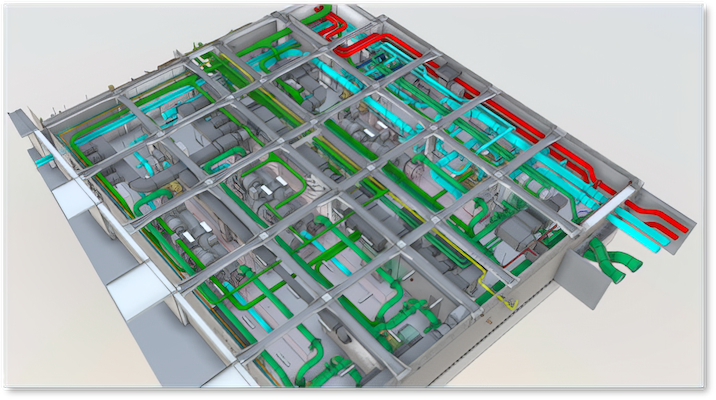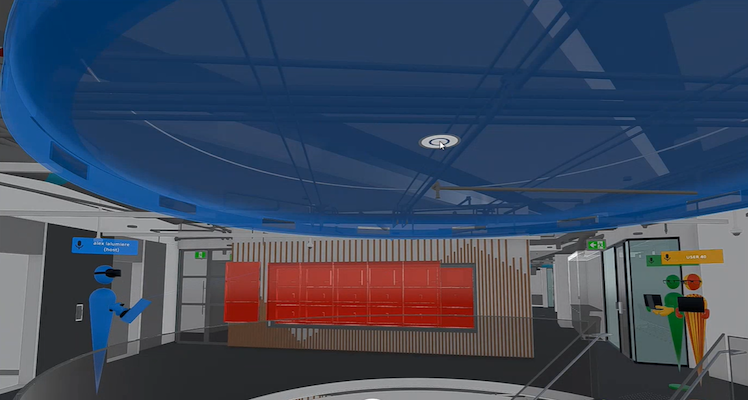
2023 #CCEAwards Showcase: Digital Acceleration Initiative
November 16, 2023
By CCE
“An important project in terms of advancement of the industry and the direction of the tools we use as we move toward the next generation of construction.” – Jury
Category: Community Outreach and In-house Initiatives
Award of Excellence Winner: WSP
Digital project delivery has become critical to achieving successful project outcomes while adapting to the changing needs of the consulting engineering industry. In 2020, WSP’s leaders in the property and buildings sector—and specifically in the structures, mechanical and electrical subsectors—launched a strategic initiative to advance technology, offer digitally integrated services and advise clients on digital asset management and decarbonization objectives.
The key steps included baseline training in building information modelling (BIM) and automation for all staff; the standardization of templates to ensure all are working from a common base on all projects; the mentoring of ‘champions’ in each business region and sector; and the development of custom workflows to enhance efficiency and quality.
Dedicated teams
WSP formed a digital solutions team, which would be dedicated to executing the ‘digital acceleration’ initiative.
With more than 760 employees and 22 offices across the country, the creation of a standard approach to BIM and custom tool development involved gathering one key leader from each region and agreeing on the standard for project delivery, including a BIM execution plan, level of development matrix, drawing standard and workflow, all in two languages.
The most impactful innovation to result from the process was a connected approach to project data, with a centralized database for all of the various software platforms needed to execute a project. This serves as a single source of the data stream, is intuitive for a non-software engineer to use, saves thousands of hours and improves quality.
WSP also formed 10 internal focus teams to work with key clients across the country, who in turn would provide the voice of industry. The teams would share WSP’s plans so clients could validate them and provide feedback on the direction for digital twins, decarbonization and automation. The purpose was also to promote industry-wide tools and set a common language for digital solutions.
Measuring progress
In addition to creating a standard baseline for project delivery that would be common across Canada and offer a ‘launching pad’ for automation, it was also important to measure the progress of WSP’s digital transformation.
Given the size of WSP’s property and buildings practice and its structures, mechanical and electrical businesses, a focused approach to change management was necessary to mobilize everyone to participate. This involved creating small teams of individuals across the business with similar day-to-day activities to select one or two ‘wildly important’ goals to achieve in their work by leveraging and adopting technology.
The challenge of covering a vast range of sectors, regions and project typologies with a standard project delivery approach was overcome by gathering experts in each sector and region to make key decisions and focus on the creation of content to be used on projects.
The bulk of the effort on the initiative was handled by the centralized digital solutions team. Removing key experts from major projects to focus on a non-billable strategic initiative took the commitment of leaders to acknowledge it would ultimately pay back to all involved. Without such a commitment from leadership, it is doubtful software platforms—such as those used nationally for reality capture, viewing of point clouds and scan-to-BIM—could be harmonized across the sectors.
Key performance indicators (KPIs) were implemented, such as efficiency improvements and time spent by production staff in Revit versus AutoCAD. By the end of 2021, the efficiency improvement metric—as measured by an overall direct labour multiplier—increased by 4.8%.
It was estimated a passive approach and lack of investment would lead to margin erosion of 10%. This erosion was not experienced, further indicating the value of the investment.
Further, the adoption metric of time spent in the aforementioned platforms flipped from 40% Revit and 60% AutoCAD at the end of 2020 to 60% Revit and 40% AutoCAD at the end of 2021. This result helped convince management to continue to invest in the program.
Through the encouragement of staff to be innovative and leverage the tools at their disposal to work more efficiently, WSP saw a marked increase in the number of modellers using Dynamo to perform parametric design tasks and streamline their work in Revit. In fact, the firm’s number of Dynamo scripts grew by 334% in October 2022 compared to the previous January.
This shift, along with the impact of 3-D coordination in the design environment prior to issuing for construction, had economic and social benefits in freeing up time for project teams to focus on ensuring quality in the final designs and reducing wasteful changes during construction.
Supporting decarbonization
With the drive toward decarbonization across the architectural, engineering and construction (AEC) industry, WSP’s property and buildings leadership teams recently committed to reducing carbon emissions from the firm’s designs, with the aspirational goal of achieving net-zero operational carbon by 2030 and net-zero embodied carbon by 2040.
With this commitment and the digital acceleration initiative in mind, the project team for a major historical building retrofit successfully created a custom application in an automated fashion to match a database of steel beams slated for removal with the new steel beams required in the retrofitted areas in an automated fashion, diverting the old beams from the waste stream.
Without the digital acceleration initiative’s baseline BIM standards, creation of a culture of innovation and focus on modified design approaches to suit decarbonization, the retrofit project’s waste diversion opportunity would either have been tackled in a manual fashion, which could have become cost-prohibitive, or simply missed altogether.
By leveraging the data from its models, WSP has been able to benchmark its past designs for hundreds of projects from a carbon-intensity perspective and to construct dashboards that report on their levels of embodied and operational carbon. From this type of benchmarking, consulting engineers will be able to identify trends and influence design decisions for new projects.
Using such data at schematic stages will allow consultants to better act as advisors to clients, offering valuable insights on how to reduce the carbon intensity of a building when it can be most heavily influenced, at the beginning of a project.
Digital Acceleration Initiative, Edmonton, Alta.
Award-winning firm (project leader): WSP, Montreal, Que. (Tom Stevens P.Eng.; Michael Jackson, P.Eng.; William Johnston, P.Eng.; Ian Shrimpton, P.Eng.; Ziad Hanna, P.Eng.; David Carnovale, P.Eng.; Tom Komon; Laura-Lee Moran; Mecale Wallenda; Lucas de Jong; Maz Karimipour, P.Eng.; Neda Karbasioun; Fred Bisson, P.Eng.; Luis Otero; Shekhar Madheshiya; Gabriel Langlois; Moughit Bouchaara).
Owner: WSP.
Other key players: n/a.

